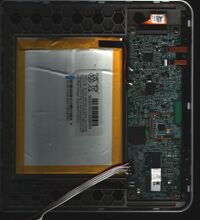Kobo Libra H2O (kobo-librah2o): Difference between revisions
mNo edit summary |
No edit summary |
||
| Line 73: | Line 73: | ||
appears. It can be accessed using a tool called uuu from a package mfgtools to start e.g. uboot from USB. So cat /dev/zero >/dev/mmcblk0 does not brick the device, | appears. It can be accessed using a tool called uuu from a package mfgtools to start e.g. uboot from USB. So cat /dev/zero >/dev/mmcblk0 does not brick the device, | ||
only a wrong U-Boot might be a problem. | only a wrong U-Boot might be a problem. | ||
== Accessing eMMC == | |||
The eMMC can be exported as mass storage also in factory u-boot enabling full backups by the following command: | |||
ums 0 mmc 0 | |||
== Installation == | == Installation == | ||
Revision as of 11:09, 19 February 2022
 insides | |
| Manufacturer | Kobo |
|---|---|
| Name | Kobo Libra H2O |
| Codename | kobo-librah2o |
| Released | 2019 |
| Hardware | |
| Chipset | Freescale i.MX6 SLL |
| CPU | 1x 1 GHz Cortex-A9 |
| GPU | PXP + EPDC |
| Display | 1680x1264 eInk |
| Storage | 8GB eMMC |
| Memory | 512M |
| Architecture | armv7 |
| Software | |
| Original software | Kobo firmware |
| postmarketOS | |
| Category | testing |
| Pre-built images | no |
| Mainline | yes |
| Flashing |
No data |
|---|---|
| USB Networking |
Works |
| Internal storage |
No data |
| SD card |
No data |
| Battery |
No data |
| Screen |
No data |
| Touchscreen |
Works |
| Multimedia | |
| Camera Flash |
No data |
| IR TX |
No data |
| Connectivity | |
| WiFi |
Works |
| NFC |
No data |
| Miscellaneous | |
| FDE |
No data |
| USB OTG |
No data |
| HDMI/DP |
No data |
| Sensors | |
| Magnetometer |
No data |
| Ambient Light |
No data |
| Proximity |
No data |
| Hall Effect |
No data |
| Haptics |
No data |
| Barometer |
No data |
Contributors
- Andi (has only a device with a broken screen)
Users owning this device
Mainlining status
A basic devicetree is upstream, display waits for testing
How to enter flash mode
Contrary to non-waterproof eBook readers, the Libra H2O does not have an internal replaceable µSD but an internal eMMC, so things have to be flashed on the device. On factory uboot fastboot mode can be entered using pagedown while powering on. Alternatively using the serial console and enter fastboot 0 on the uboot prompt. Note: if nothing which looks like a bootloader is found on startup, the following device
hid-generic 0003:1FC9:0128.001B: hiddev1,hidraw1: USB HID v1.10 Device [ NXP SemiConductor Inc SE Blank 6SLL] on usb-0000:00:14.0-6.1/input0
appears. It can be accessed using a tool called uuu from a package mfgtools to start e.g. uboot from USB. So cat /dev/zero >/dev/mmcblk0 does not brick the device, only a wrong U-Boot might be a problem.
Accessing eMMC
The eMMC can be exported as mass storage also in factory u-boot enabling full backups by the following command:
ums 0 mmc 0
Installation
See also
- U-boot and kernel source
- Upstream Devicetree Source (dts)
- branches kobo/merged-5.X Patched mainline kernels (includes EPD), currently kobo/drm-merged-5.15
- branch kobo-2020-10 more recent u-boot behaving more normal, see corresponding wiki for details
- Wi-Fi driver, branch rtl8189fs